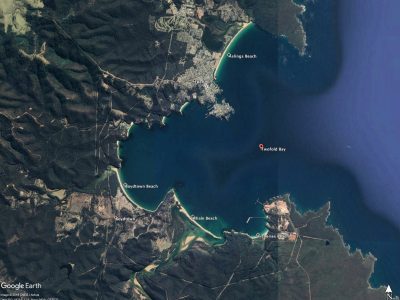Twofold Bay – A Great Coastal Laboratory

Last week Irene and I had the pleasure of attending the 80th birthday celebration of Roger McLean. The venue was Edrom Lodge on the south side of Twofold Bay located on the New South Wales south coast. It was a family gathering with a few old friends and it provided an excellent opportunity to pay tribute to Roger’s contributions to physical geography and coastal science as well as his dedication to teaching in Australia and New Zealand. Edrom Lodge had been used by Roger and staff from ADFA as the location for many field schools. From the perspective of coastal geomorphology and sedimentology there are few better places where one can demonstrate a range of features that show contrasting depositional histories than Twofold. And this commences on the beach situated right below the lodge itself.
One of the most extraordinary landforms along the south coast of NSW are the fossil cliffs. I first became captivated by them in Batemans Bay where they occur on both sides of the bay. Years ago a prominent relic stack carved into folded Palaeozoic rocks existed along the road to Batehaven. Unfortunately it was destroyed in order to widen the road. But the cliffs form a vegetated backdrop to homes, caravan parks and public spaces often with remnants at their base of degraded rock platforms. Similar features are to be found at the rear of strand plains north of the Moruya River and also behind Boydtown at the west end of Twofold Bay. Within Twofold Bay, these ancient cliffs are quite prominent at the back of small, north-facing embayments, in places so heavily vegetated that it is hard to photograph. When were they formed, how long did it take to carve these cliffs and platforms into tough folded rocks, and where was all the sand and mud that filled these bays in the Holocene during the period(s) these cliffs were actively being attacked by waves? We puzzled over different possibilities and then switched our attention to the sedimentary deposits that form beaches and sand plains around Twofold Bay.
Work by John Hails, and later John Hudson and Peter Roy, helped establish a remarkable pattern of sediment types that occur at and below sea level in Twofold Bay. These deposits are all of Holocene age. Hails had studied the well-rounded, quartz sands at Aslings Beach, near Eden, on the north side of the Bay. Hudson (1991) brought much of the existing information together in his study of the late Holocene evolution of marine and terrestrial deposits in the Twofold Bay area.
With us last week was Tom Oliver who has dated the strand plain sands of the Boydtown compartment using OSL method. This study built on an earlier C14 story of mine and the work of Hudson, Roy and Hails. We looked at Kiah Inlet with its large sand barrier and steep beachface (Whale Beach) composed of mixed minerals including feldspars. Tom had found some of this type of sand, but quite a bit finer, in the outer Boydtown ridges. Yet at the back of Kiah Inlet there are vegetated sand flats at the old Davidson’s Whaling Station composed of very fine, well sorted carbonate sand. Coarser, angular and felspathic sands occur on the active beach. However, there is no sign of this coarse lithic sand in the next bay to the east, Fisheries. What incredible contrasts. We speculated that in mid-Holocene the southern section of Twofold Bay was dominated by calcareous deposits. As the Towamba River prograded into the Kiah Inlet, a sediment switch occurred with Whale Beach forming of coarse sand leaking to the west into Boydtown. There was no leakage to the east. All this should be tested, building on John Hudson’s sediment texture and compositional work of the barriers and nearshore deposits of the Bay and on Tom’s OSL dating.
One further thing I found fascinating this time wandering around the shores of Twofold Bay was the differentiation of shell types in different bays. There were slightly different shell signatures and they changed over time. For instance, Roger informed me that Whale Beach is rich in Bankivia species yet we saw no sign of this lovely banded gastropod elsewhere. Glycymeris species was abundant on the beach at Davidson’s, but not in the shell layer that capped the relict carbonate sands behind the beach. And the next beach to the east, Fisheries, with its carbonate sands had no Glycymeris. We also noted Aboriginal middens containing large mud oysters (Ostrea angasi); this shell species is very rare today. All these features make a visit to Twofold Bay a joy to behold.
Bruce Thom
Words by Prof Bruce Thom. Please respect the author’s thoughts and reference appropriately: (c) ACS, 2018, posted 16 October 2018, for correspondence about this blog post please email austcoastsoc@gmail.com
#122


 Notice of Australian Coastal Society 2018 AGM
Notice of Australian Coastal Society 2018 AGM